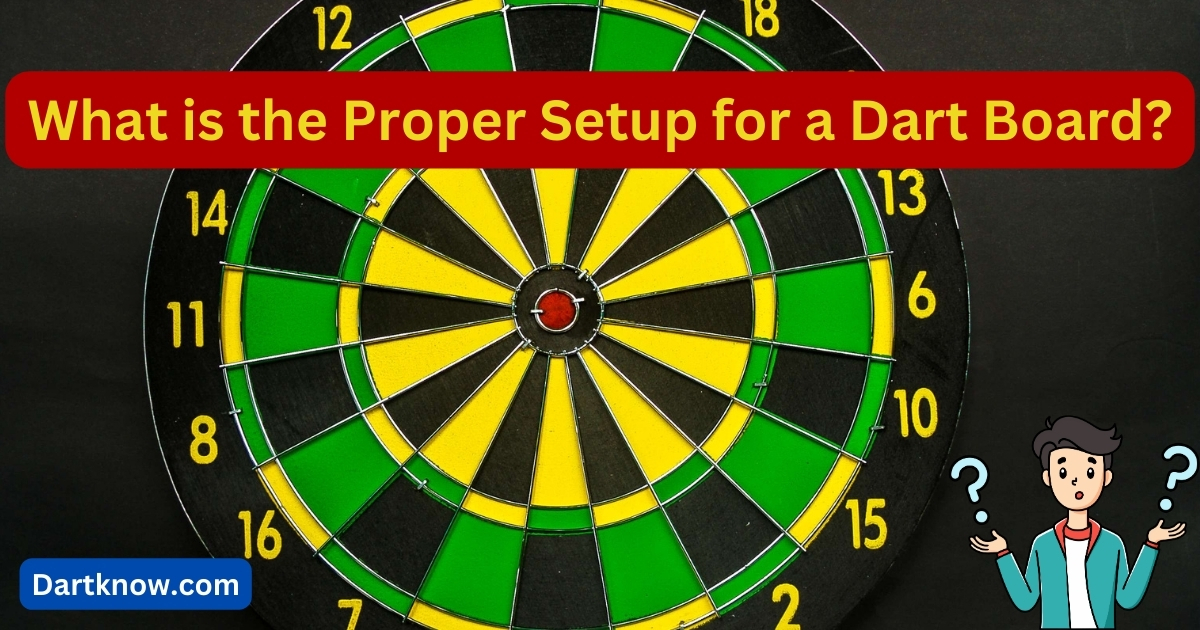What is the Proper Setup for a Dart Board

Understanding what is the proper setup for a dart board is crucial for equitable play, safety, and reliable performance. The correct dartboard height and distance are crucial to prevent accidents and ensure accurate throws. Adequate dartboard lighting enhances visibility and improves gameplay.
By adhering to standard measurements, players can create an optimal environment for practice or competition. Positioning the bullseye at exactly 5 feet 8 inches and maintaining a 7 feet 9.25 inches distance between the throwing line (oche) and the board are fundamental for a standardized dartboard setup. This consistency allows players to seamlessly transition between different playing areas.
Knowing what is the proper setup for a dart board ensures that players can enjoy the game under ideal conditions.
Ideal Dartboard Placement: Choosing the Right Location
Adequate Space for Playing Area
You should always ensure enough room around the dartboard when choosing a location. Five feet is the suggested minimal width for the playing subject, giving gamers plenty of area to stand and throw darts without difficulty.
To accommodate the throwing distance and prevent obstructions from obstructing play, there must also be at least eleven feet of unobstructed area in the front of the board.
Lighting Requirements
A good lighting setup is essential for the best possible darts game. The dartboard shouldn’t be shadowed, and the playing area should have adequate lighting. Consider installing a dedicated light source around the dartboard to improve visibility and lessen eye strain, like an LED light ring or spotlight. Lighting immediately above or behind the player should be avoided since this may cause glare or shadows that could impair accuracy.
Wall Protection
Installing a backboard or dartboard surround will shield your wall from errant darts and possible damage. By catching darts that skip the board, these safety precautions can maintain the integrity of the wall and the darts.
Popular options for dartboard surrounds include cork or foam since they are long-lasting, offer sufficient protection, and look good.
Understanding Dartboard Specifications for Optimal Play
Types of Dart Boards
- Bristle Dart Boards: The most unusual and conventional dart board, especially in expert settings, is the bristle dart board. Bristle dart boards are self-recovery due to the fact they are fabricated from sisal (agave) fibers; this is, after the darts are taken out, the holes they made close up. Their sturdiness makes them a terrific option for ordinary use.
- Electronic Dart Boards: Usually built of plastic, these boards have digital sensors established that permit them to robotically file the score while a dart is fired. Electronic forums are incredible for recreational play because they offer a wide range of games and versions, making the revel more participatory. Soft-tip darts are intended for use with them.
- Magnetic Dart Boards: Magnetic dart forums are high-quality for more youthful game enthusiasts or those looking for a safer alternative. They use darts with flat recommendations, which can be magnetized and adhere to the board’s steel floor.
Size and Configuration
A dart board’s ordinary dimensions are 18 inches in diameter, with the bullseye within the middle. The board is cut up into 20 numbered portions, the outer bullseye (unmarried bull), the inner bullseye (double bull), and the double and treble ring regions.
A correctly configured set of segments guarantees that they are marked and spaced equally, giving every participant a level playing field.
Mounting Hardware
Securing the dartboard to the wall requires the use of the right mounting hardware. Bristle dart boards normally include a wall plug system and metal brackets or screws to provide a level and solid installation. Electronic dart boards frequently consist of additional mounting instructions and hardware to assist the heavier weight of the board.
Follow the manufacturer’s directions and use the required device to ensure the dartboard is firmly attached, positioned at the correct height, and spaced from the oche.
How to Properly Mount Your Dartboard

Height from Floor to Bullseye
To assure impartial and constant gameplay, the bullseye’s center wishes to be precisely 5 feet 8 inches (1.73 meters) above the ground. This height is universally recognized in both casual and professional dart games. Before mounting the board, note this height on the wall with a tape measure.
Distance from the Throw Line (Oche)
The proper distance is 2.37 meters (7 feet 9.25 inches) from the face of the dartboard to the oche, or throw line. The integrity of the sport and standard policies depend on maintaining this distance. Use a tape measure to mark the throwing distance on the floor, and consider using tape or a throw line mat for clear differentiation.
Securing the Dart Board to the Wall
To stop movement during play, the dartboard must be securely fastened to the wall. Follow these steps for secure mounting:
- To find a substantial section of the wall, such as a stud, for better support, use a stud finder.
- At five feet 8 inches above the ground, mark the peak at which the bullseye’s middle may be.
- Make certain the mounting bracket is level and firmly constant before the use of screws and wall plugs to connect it to the wall.
- When using bristle boards, center the dart board on the bracket and fasten it firmly with the included fasteners.
- For electronic dart boards, follow the manufacturer’s additional mounting instructions and use the provided hardware to handle the heavier weight.
- Ensure the board is flush with the wall and does not wobble.
Following these steps meticulously will create a sturdy and standardized setup for enjoyable and consistent gameplay.
Determining the Correct Oche Distance: Measuring the Throw Line

Standard Distance from the Board
The common distance is 7 ft nine.25 inches (2.37 meters) from the dartboard face to the throw line, additionally referred to as the oche. To maintain a controlled and equitable game that adheres to professional standards, this measurement is necessary.
To achieve a correct distance, it’s miles essential to measure from the front of the dartboard, not the wall, to the throwing line.
Marking the Throw Line on the Floor
To mark the throw line on the floor, use a tape measure to measure the standard distance from the dartboard. Place a visible marker at this point, ensuring it is straight and aligned with the center of the bullseye. You can use adhesive tape, chalk, or a pre-made throw line mat for precise and clear delineation. Ensure that the throw line is continuously visible and unobstructed, allowing players to position themselves correctly during gameplay.
Options for Permanent and Temporary Lines
- Permanent Lines: For a long-lasting solution, consider using floor tape specifically designed for this purpose. Another option is to install a throw line mat that can be permanently affixed to the floor. Some players opt for engraving or painting, which provides a robust and enduring mark but requires careful measurement and precision.
- Temporary Lines: Temporary Lines: The throw line might be marked with chalk or adhesive tape for a less permanent solution. These components are readily detachable and adaptable. Portable throw line mats are another excellent temporary solution, offering clear marking without permanent alteration to the floor. These mats are beneficial in multi-purpose spaces or when the dart setup is temporary.
Proper Setup for a Dart Board: Additional Considerations
Safety Precautions
Safety should always be a priority when playing darts. Ensure the dartboard is firmly fixed and there are no valuables or obstructions in the immediate vicinity. Younger players should use magnetic dart boards or soft-tip darts to reduce the chance of harm.
Create a safe playing area where spectators can remain away from the throwing path and are aware that the game is underway.
Maintenance of the Dart Board
The dartboard may be kept in peak playing condition and have its lifespan extended with regular maintenance. To disperse wear uniformly among bristle boards, rotate the board from time to time. To wipe the board surface and remove dirt, use a dry towel; do not use water or cleaning solutions as they might cause damage to the fibers. Regular dusting and inspection of electronic boards for loose connections or malfunctioning devices are recommended.
To ensure that the board remains intact, always adhere to the manufacturer’s care instructions.
Choosing the Right Darts
Choosing the right darts can significantly impact The enjoyment of playing darts. Steel-tip darts provide the specified penetration and stability, making them the perfect supplement to bristle dartboards. Soft-tip darts are made specifically for digital dartboards, and their plastic suggestions lower the threat of injury and harm to the board. Match player preferences and skill levels with the darts’ weight and grip.
Expert players might feel that heavier darts are easier to control, while novices might find lighter darts more manageable. Make sure the darts are always in line with standard rules and are well-balanced.
FAQs
How to properly set up a dart board?
The bullseye of the dartboard should be hung 5 feet 8 inches above the floor, and the throwing line should be spaced 7 feet 9.25 inches from the dartboard.
How far should the throw line be from the dartboard?
The distance between the dartboard face and the oche, or throw line, must be 7 feet 9.25 inches (2.37 meters). This standard distance ensures the integrity of the game and aligns with professional regulations.
What type of wall should I mount my dartboard on?
Mount your dartboard on a sturdy wall such as one with masonry or wooden studs for the greatest results. This will provide it with the required stability. Locating a firm place with a stud finder guarantees stable mounting and keeps the board from shifting while playing.
Conclusion
Correct dartboard setup necessitates a few vital movements to assure player protection and consistency. Mounting the dartboard at the required top of five feet 8 inches and figuring out the throw line’s popular distance of 7 toes nine.25 inches were the subjects of debate. We also covered securing the dartboard to the wall properly for stability. Marking the throw line is crucial for fairness and alignment with professional standards.
Adhering to standard setup protocols in dart games is crucial for fairness, skill development, and safety. It ensures professional conditions, minimizes disputes, and maintains an enjoyable and consistent player experience.




